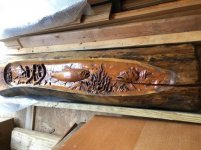swamp dweller
Cast Iron
- Joined
- Jun 10, 2010
- Location
- Central Florida USA
My wife and I are building a fishing camp on the St Lawrence river in upstate New York and we are doing it on a what ever we can save every year to put into it ,we do, then wait til next year and do some more. I don't want a mortgage when it's done. Any way, My wife saw this mantel on line and bought it for me for Fathers day last year. It's been, CNC routered ,(I assume) with a fish motif on the front.The problem is when it arrived last Fathers Day it had some little cracks on the ends making it look quite rustic and I thought very cool. Since we aren't to the fireplace building part of construction yet I put it back in the box and left it in the spare bedroom for the last almost year. I had some friends over and wanted to show them and when I opened the box the little rustic cracks last year have become major splits that are threatening to split the thing in halve. Of course they run right thru the center of the motif. The one end has an opening of about 1/2 in. The picture with the long screw in it I was going to try to run that thru from the top and try to pull it back together but thought I should get a second opinion. I'm a toolmaker,not a wood worker.
Is there any way to salvage this log? It's supposed to be cherry.
Any suggestion will be greatly appreciated.



Is there any way to salvage this log? It's supposed to be cherry.
Any suggestion will be greatly appreciated.




Last edited:

